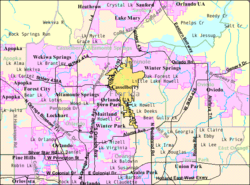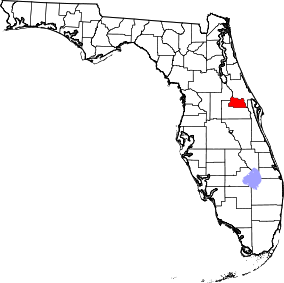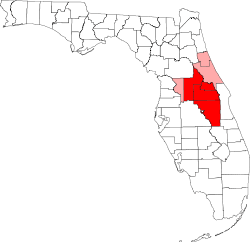Casselberry, Florida
| Casselberry, Florida | ||
|---|---|---|
| City | ||
| City of Casselberry | ||
| ||
 Location in Seminole County and the state of Florida | ||
 U.S. Census Map | ||
| Coordinates: 28°39′40″N 81°19′19″W / 28.66111°N 81.32194°WCoordinates: 28°39′40″N 81°19′19″W / 28.66111°N 81.32194°W[1] | ||
| Country | United States | |
| State | Florida | |
| County | Seminole | |
| Incorporated | 1940 | |
| Government | ||
| • Type | Commission–Manager | |
| • Mayor | Charlene Glancy | |
| Area[1] | ||
| • Total | 7.6 sq mi (20 km2) | |
| • Land | 7.0 sq mi (18 km2) | |
| • Water | 0.6 sq mi (2 km2) | |
| Elevation[2] | 56 ft (17 m) | |
| Population (2010)[3] | ||
| • Total | 26,241 | |
| • Density | 3,751.9/sq mi (1,448.6/km2) | |
| Time zone | EST (UTC-5) | |
| • Summer (DST) | EDT (UTC-4) | |
| ZIP code(s) | 32707 | |
| Area code(s) | 321, 407 | |
| FIPS code | 12-11050[3] | |
| GNIS feature ID | 0280117[2] | |
| Website | www.casselberry.org | |
Casselberry is a city in Seminole County, Florida, United States. The population was 26,241 at the 2010 census.[4] The city is usually considered linked to the Orlando–Kissimmee–Sanford Metropolitan Statistical Area.
Geography

Casselberry is located at 28°39′40″N 81°19′19″W / 28.661183°N 81.321926°W.[2]
According to the United States Census Bureau, the city has a total area of 7.1 square miles (18 km2). 6.7 square miles (17 km2) of it is land and 0.4 square miles (1.0 km2) of it (6.06%) is water.
Casselberry features over 30 lakes and ponds, the largest being Lake Howell, the Triplet Chain of Lakes, Lake Kathryn, and Lake Concord.
History
Prior to European settlement in the 19th-century Native American groups inhabited the Seminole County area, including land in present-day Casselberry. A blockhouse known as Fort Concord was constructed on the shores of Lake Concord in 1849 to protect local settlers during conflicts between the Seminole Wars.
After the Homestead Act was passed in 1862, settlers began homesteading the land around Lake Concord and the Triplet Chain of Lakes. Annie E. Griffin of Eastman, Georgia platted the area’s first subdivision in 1889 after inheriting the land from her deceased husband.
An African-American community cemetery, called Evergreen Cemetery, was established in 1903 under the care of a group of trustees from surrounding communities. In 1925, Gordon J. Barnett of New York came to Altamonte Springs and acquainted himself with all aspects of the local fern industry and soon opened his own fernery. Barnett then began a housing development west of Lake Concord called Fern Park Estates, composed of small lots and including a fernery for individual owners.

In 1926, Hibbard Casselberry of Winnetka, Illinois was visiting his wife’s aunt in nearby Winter Park, Florida when he met Gordon Barnett and signed on as his exclusive sales agent for Fern Park Estates. Casselberry and Barnett split soon after but Casselberry purchased land surrounding Fern Park Estates and began platting his own subdivision: Winter Park Ferneries.
The area became known as Fern Park and a post office was established under that name in 1928. Casselberry continued to develop and expand his fernery and real estate business throughout the 1930s while Barnett was elected to the Florida House of Representatives in 1937. When Barnett introduced a bill to incorporate the Town of Fern Park it was passed and moved to the senate before Fern Park residents could petition the bill, and then Barnett withdrew it.
Hibbard Casselberry convinced the residents of Fern Park that the best way to avoid property taxes was to incorporate their own tax-free town. A town meeting was held on October 10, 1940 where the tax-free Town of Casselberry was officially incorporated, including parts of Barnett’s Fern Park Estates. As more property was brought into the city limits of Casselberry, the area of Fern Park was pushed further south towards SR 436. With the beginning of World War II the ferneries were declared non-essential and Hibbard Casselberry secured government contracts for the manufacturing of bandoliers, bomb parachutes, and hospital tent liners. The city returned to the fern industry after the war but also continued work in textiles and Johnson Electronics became a major employer for the city in the 1950s.
Despite the fact that Casselberry was an incorporated town and Fern Park remained unincorporated the United States Postal Service refused to grant Casselberry its own post office due to a policy prohibiting the naming of post offices after living persons. Casselberry established a contract post office in 1957 at its own expense and the town was finally granted a post office in 1959, although Hibbard Casselberry lived another ten years. The City of Casselberry was incorporated on July 25, 1965 and Casselberry’s citizens eventually voted to have property taxes in 1976. Casselberry’s first city hall was dedicated in 1970 and comprises part of the current municipal complex.
Demographics
| Historical population | |||
|---|---|---|---|
| Census | Pop. | %± | |
| 1950 | 407 | — | |
| 1960 | 2,463 | 505.2% | |
| 1970 | 9,438 | 283.2% | |
| 1980 | 15,037 | 59.3% | |
| 1990 | 18,911 | 25.8% | |
| 2000 | 22,629 | 19.7% | |
| 2010 | 26,241 | 16.0% | |
| Est. 2015 | 27,056 | [5] | 3.1% |

As of the 2010 U.S. Census,[3] there were 26,241 people, 11,430 households, and 6,398 families residing in the city. The population density was 3,751.9 inhabitants per square mile (1,448.6/km²). There were 12,708 housing units. The racial makeup of the city was 80.1% White, 8.0% African American, 0.4% Native American, 2.9% Asian, 0.1% Pacific Islander, 4.9% from other races, and 3.5% from two or more races. Hispanic or Latino of any race were 22.6% of the population.
There were 11,430 households out of which 23.1% had children under the age of 18 living with them, 35.8% were married couples living together, 14.8% had a female householder with no husband present, and 44.0% were non-families. 32.5% of all households were made up of individuals and 10.1% had someone living alone who was 65 years of age or older. The average household size was 2.29 and the average family size was 2.92.
The median income for a household in the city was $44,807, and the median income for a family was $51,371. The per capita income for the city was $24,184. About 14.7% of the population were below the poverty line.
Education
Elementary
Middle
Private schools
- Kenworthy School
- Lawton Chiles Preparatory School
Parks and recreation
The City of Casselberry maintains 17 parks ranging from small neighborhood parks to large centers for recreation. Some of these parks include:
- Anniversary Park
- Branch Tree Park
- Crystal Bowl Park
- Dew Drop Park
- Lake Hodge Park
- Pawmosa Dog Park
- Plumosa Oaks Park
- Red Bug Lake Park
- Rotary Park
- Secret Lake Park
- Sunnytown Park
- Sunset Park
- Veterans Memorial Park
- Wirz Park
Sports
Seminole Speedway was located in Casselberry, operating between 1945 and 1954, and hosting stock car, Modified, and motorcycle racing.
Notable people
- Chandler Parsons, basketball player for the Dallas Mavericks
- Nick Calathes, basketball player for the Memphis Grizzlies
- Pat Calathes, basketball player for the Israeli club Maccabi Haifa
- Hedy Lamarr, Austrian-born actress and inventor.[7]
- Robert James Miller, Medal of Honor Recipient buried at All Faiths Memorial Park.
References
- 1 2 "US Gazetteer files: 2010, 2000, and 1990". United States Census Bureau. 2011-02-12. Retrieved 2011-04-23.
- 1 2 3 "US Board on Geographic Names". United States Geological Survey. 2007-10-25. Retrieved 2008-01-31.
- 1 2 3 "American FactFinder". United States Census Bureau. Archived from the original on September 11, 2013. Retrieved 2008-01-31.
- ↑ http://factfinder.census.gov/servlet/SAFFPopulation?_event=ChangeGeoContext&geo_id=16000US1211050&_geoContext=01000US%7C04000US12%7C16000US1241250&_street=&_county=Casselberry%2C+FL&_cityTown=Casselberry%2C+FL&_state=&_zip=&_lang=en&_sse=on&ActiveGeoDiv=geoSelect&_useEV=&pctxt=fph&pgsl=010&_submenuId=population_0&ds_name=null&_ci_nbr=null&qr_name=null®=null%3Anull&_keyword=&_industry=
- ↑ "Annual Estimates of the Resident Population for Incorporated Places: April 1, 2010 to July 1, 2015". Retrieved July 2, 2016.
- ↑ "Census of Population and Housing". Census.gov. Archived from the original on April 22, 2013. Retrieved June 4, 2015.
- ↑ http://articles.orlandosentinel.com/2000-01-20/news/0001200121_1_hedy-lamarr-casselberry-white-cargo
External links
- Casselberry Economic Development
- City of Casselberry
- Seminole County Convention and Visitors Bureau
- Seminole Country Public Schools



